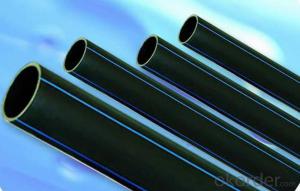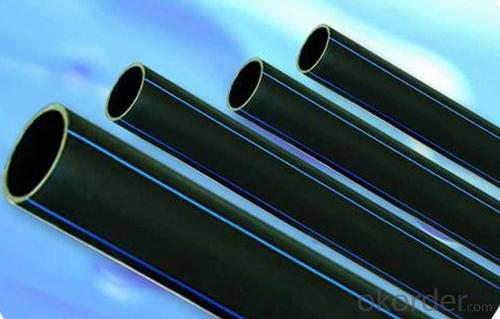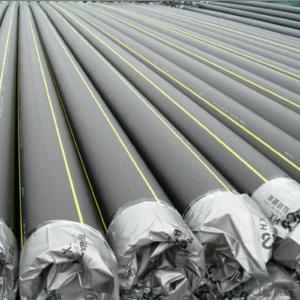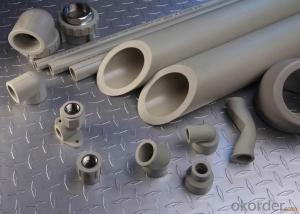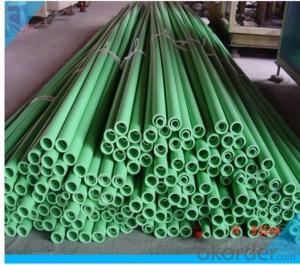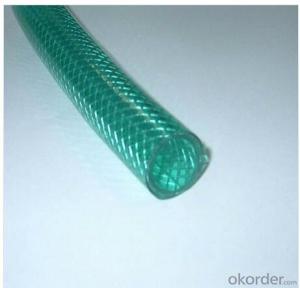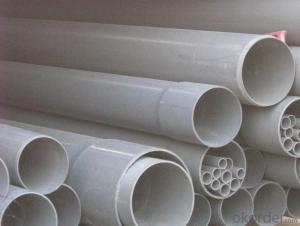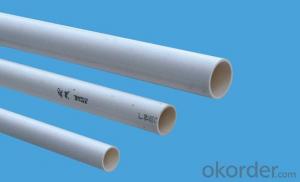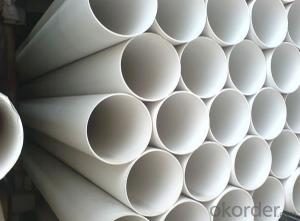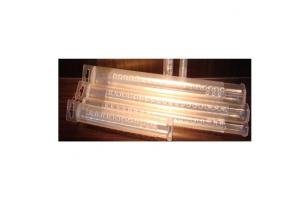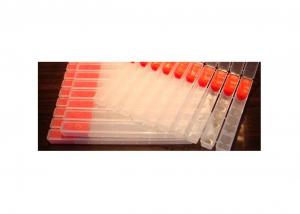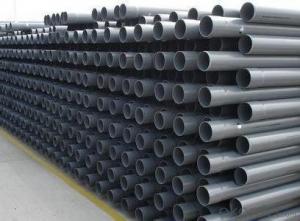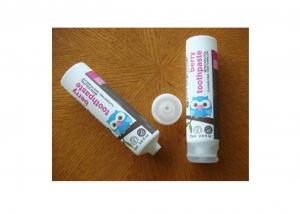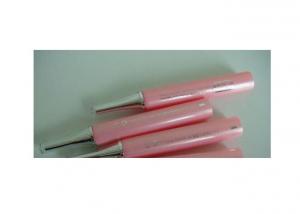HDPE Pipe ISO4427-2000 DN20 Plastic Tubes for Posters
- Loading Port:
- China Main Port
- Payment Terms:
- TT OR LC
- Min Order Qty:
- -
- Supply Capability:
- -
OKorder Service Pledge
OKorder Financial Service
You Might Also Like
Physical properties[edit]
Polyethylene is a thermoplasticpolymer consisting of long hydrocarbon chains. Depending on the crystallinity and molecular weight, a melting point and glass transition may or may not be observable. The temperature at which these occur varies strongly with the type of polyethylene. For common commercial grades of medium- and high-density polyethylene the melting point is typically in the range 120 to 180 °C (248 to 356 °F). The melting point for average, commercial, low-density polyethylene is typically 105 to 115 °C (221 to 239 °F).it is transprant.
Chemical properties[edit]
Most LDPE, MDPE and HDPE grades have excellent chemical resistance, meaning that it is not attacked by strong acids or strong bases. It is also resistant to gentle oxidants and reducing agents. Polyethylene burns slowly with a blue flame having a yellow tip and gives off an odour of paraffin. The material continues burning on removal of the flame source and produces a drip.[3] Crystalline samples do not dissolve at room temperature. Polyethylene (other than cross-linked polyethylene) usually can be dissolved at elevated temperatures in aromatic hydrocarbons such as toluene or xylene, or in chlorinated solvents such as trichloroethane or trichlorobenzene.[4]
GB/T13663-2000:
| PE63管材规格 | |||||
| 公称 外径dn,mm | SDR33 | SDR26 | SDR17.6 | SDR13.6 | SDR11 |
| 公称压力 PN,Mpa | |||||
| 0.32 | 0.4 | 0.6 | 0.8 | 1.0 | |
| 公称 壁厚 | 公称 壁厚 | 公称 壁厚 | 公称 壁厚 | 公称 壁厚 | |
| 16 | 2.3 | ||||
| 20 | 2.3 | 2.3 | |||
| 25 | 2.3 | 2.3 | 2.3 | ||
| 32 | 2.3 | 2.4 | 2.9 | ||
| 40 | 2.3 | 2.3 | 3.0 | 3.7 | |
| 50 | 2.3 | 2.9 | 3.7 | 4.6 | |
| 63 | 2.3 | 2.5 | 3.6 | 4.7 | 5.8 |
| 75 | 2.3 | 2.9 | 4.3 | 5.6 | 6.8 |
| 90 | 2.8 | 3.5 | 5.1 | 6.7 | 8.2 |
| 110 | 3.4 | 4.2 | 6.3 | 8.1 | 10.0 |
| 125 | 3.9 | 4.8 | 7.1 | 9.2 | 11.4 |
| 140 | 4.3 | 5.4 | 8.0 | 10.3 | 12.7 |
| 160 | 4.9 | 6.2 | 9.1 | 11.8 | 14.6 |
| 180 | 5.5 | 6.9 | 10.2 | 13.3 | 16.4 |
| 200 | 6.2 | 7.7 | 11.4 | 14.7 | 18.2 |
| 225 | 6.9 | 8.6 | 12.8 | 16.6 | 20.5 |
| 250 | 7.7 | 9.6 | 14.2 | 18.4 | 22.7 |
| 280 | 8.6 | 10.7 | 15.9 | 20.6 | 25.4 |
| 315 | 9.7 | 12.1 | 17.9 | 23.2 | 28.6 |
| 355 | 10.9 | 13.6 | 20.1 | 26.1 | 32.2 |
| 400 | 12.3 | 15.3 | 22.7 | 29.4 | 36.3 |
| 450 | 13.8 | 17.2 | 25.5 | 33.1 | 40.9 |
| 500 | 15.3 | 19.1 | 28.3 | 36.8 | 45.4 |
| 560 | 17.2 | 21.4 | 31.7 | 41.2 | 50.8 |
| 630 | 19.3 | 24.1 | 35.7 | 46.3 | 57.2 |
- Q: How do you connect plastic tubes together?
- Plastic tubes can be connected together using various methods such as push-to-connect fittings, barbed fittings with hose clamps, threaded connectors, solvent welding, or using adhesive products specifically designed for plastic bonding. The choice of method depends on the type of plastic, the application, and the desired strength and permanence of the connection.
- Q: why does water bend when put in a plastic tube?
- Two reasons: 1. Water flow following the path of least resistance and hence it has to move within the tube. 2. When there is a difference in height of the tube it has to maintain the equal level at either end. VR
- Q: Can plastic tubes be used for insulation?
- Yes, plastic tubes can be used for insulation. Plastic tubes, such as PVC or polyethylene tubes, can provide insulation by creating a barrier between the object being insulated and the surrounding environment. This helps prevent heat transfer, keeping the object protected from temperature changes. Plastic tubes are commonly used in various applications, including HVAC systems, plumbing, and electrical wiring, to provide insulation and maintain desired temperatures.
- Q: Can plastic tubes be used for oxygen delivery in medical applications?
- Yes, plastic tubes can be used for oxygen delivery in medical applications. They are commonly used in hospitals and healthcare facilities for delivering oxygen to patients through nasal cannulas or face masks. Plastic tubes are lightweight, flexible, and easily disposable, making them convenient and safe for oxygen delivery in medical settings.
- Q: I cant find them online and i need some.
- They have two names from what i know of 1. Twice as nice 2. Gator pops hope this helps
- Q: What are the advantages of using plastic tubes in packaging?
- One advantage of using plastic tubes in packaging is their versatility. Plastic tubes can be easily molded into various shapes and sizes, making them suitable for packaging products of different dimensions. Additionally, plastic tubes are lightweight, which reduces shipping costs and makes them convenient for consumers to carry. Another advantage is the durability of plastic tubes, as they can withstand impact and protect the contents from external factors such as moisture and light. Furthermore, plastic tubes are transparent or can be made translucent, allowing consumers to see the product inside, which can be appealing for marketing purposes. Finally, plastic tubes are often recyclable, contributing to sustainability efforts and reducing environmental impact.
- Q: Can plastic tubes be used for vacuum packaging?
- Yes, plastic tubes can be used for vacuum packaging.
- Q: I would like to connect a Maytag icemaker valve to 1/4 plastic tubing. This is not for use in an actual ice maker. I've tried using a compression fitting from Home Depot, but it leaks between the tubing and fitting. Using the collar and insert pieces don't make a difference.Any idea on how to securely connect this two parts?
- I never did like plastic, try copper tubing.
- Q: me and my father were trying to fix a leaf blower(the cord you have to pull will come out but won't go in) and ran into a few problems. we had to pull the whole thing apart to get to it, and along with pulling everything off we had to take off the switches that handle choke and run, and the tubes connected to this device were corroded from gas left in the leaf blower. where can i buy this tubing, and some sealant for the tubes? i DO NOT want a website that i can order them from, i want an ACTUAL store in the Dallas fort worth area.
- any ace hardware most hardware stores carry it
- Q: What are the disadvantages of welded steel pipe and plastic pipe?. More points, bonus points
- The technology of this product determines its advantages and disadvantages. Generally, the welded steel pipe has high accuracy, uniform wall thickness, high brightness inside and outside the pipe (the surface brightness of the steel pipe surface determined by the steel plate), and can be arbitrarily fixed. Therefore, it reflects its economy and beauty in the application of high precision, medium and low pressure fluid.
Send your message to us
HDPE Pipe ISO4427-2000 DN20 Plastic Tubes for Posters
- Loading Port:
- China Main Port
- Payment Terms:
- TT OR LC
- Min Order Qty:
- -
- Supply Capability:
- -
OKorder Service Pledge
OKorder Financial Service
Similar products
Hot products
Hot Searches
Related keywords
